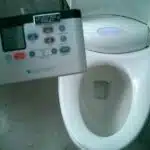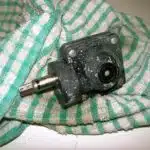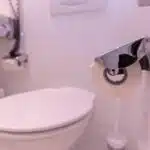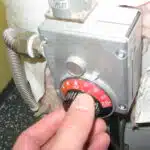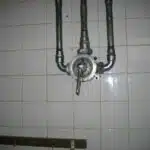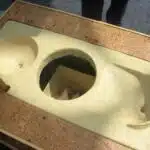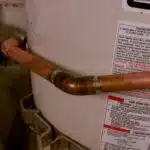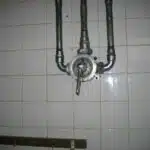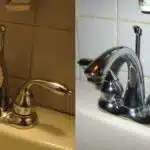A malfunctioning toilet fill valve can be a frustrating issue, causing water waste and potentially leading to more serious plumbing problems. However, with the right tools and knowledge, replacing a toilet fill valve is a straightforward task that can be accomplished by even novice DIY enthusiasts. In this article, we will provide step-by-step instructions for replacing a toilet fill valve along with helpful tips and tricks to ensure a successful repair.
As plumbing experts, we understand the importance of maintaining optimal functionality in all aspects of your home’s plumbing system. As such, we believe that sharing our expertise on replacing a toilet fill valve can not only save you money on costly repairs but also help you serve your household in a practical way. By following our guide, you’ll be able to replace your faulty fill valve quickly and efficiently, ensuring that your toilet operates smoothly and efficiently for years to come.
Diagnosing A Faulty Fill Valve
Toilet fill valves are essential components of a properly functioning toilet system. These valves control the flow of water into the toilet tank, which in turn controls the amount of water available for flushing. However, over time, these valves can become faulty and require replacement.
The first step in replacing a toilet fill valve is to diagnose whether or not it is actually faulty. Testing functionality is a crucial step in this process. One common way to do this is by turning off the water supply to the toilet and then flushing it. If no water enters the tank after flushing, it’s likely an issue with the fill valve. Another method involves opening up the tank and examining the fill valve directly for any visible signs of damage or wear.
Common causes of a faulty fill valve include mineral buildup from hard water, damage caused by harsh chemicals or excessive force during cleaning, and general wear and tear over time. It’s important to note that a faulty fill valve can lead to a range of problems including inconsistent flushing, slow filling tanks, and even leaks.
Once you have determined that your fill valve needs replacing, it’s important to gather all necessary tools and supplies before proceeding with the installation process. This will help ensure that you have everything you need on hand and can complete the job efficiently without any unnecessary delays or complications.
Gathering The Necessary Tools And Supplies
Before beginning the process of replacing a toilet fill valve, it is important to gather all necessary tools and supplies. This will not only save time but also ensure that the job is completed efficiently. The tools and supplies required for this task are readily available at any hardware store or home improvement center.
The first tool needed is a pair of pliers, which can be used to loosen nuts and bolts. A bucket or container may also be helpful in catching any water spillage during the process. Other necessary supplies include a new fill valve, Teflon tape, and a sponge or rag to clean up any excess water. It is important to choose a cost-effective option when purchasing a new fill valve as there are many available on the market with varying prices.
Common mistakes made during this process include forgetting to shut off the water supply before beginning work, not tightening connections enough leading to leaks, and using incorrect parts causing malfunctioning. By gathering all necessary tools and supplies beforehand, these mistakes can be avoided. In the subsequent section, we will discuss how to properly shut off the water supply before proceeding with replacing the toilet fill valve.
Shutting Off The Water Supply
As a plumbing expert, shutting off the water supply is the first step in replacing a toilet fill valve. Before you start any work, it is important to cut off the water so that you don’t end up with a flood in your bathroom. The best way to do this is to locate the shutoff valve and turn it clockwise until it stops.
To locate the shutoff valve, you may have to look behind or near the toilet itself. It may be on the wall or floor and may look like a small knob or lever. If you can’t find it there, check your home’s main water shutoff valve. Once you have found it, use pliers or an adjustable wrench to turn it clockwise.
The tools needed for shutting off the water supply are pretty simple: pliers or an adjustable wrench. Make sure that you have these tools before beginning any work on your toilet fill valve replacement project. This will save you time and effort in having to search for them later on. With the water shut off, we can now move onto draining the tank and bowl.
Draining The Tank And Bowl
After shutting off the water supply, it is time to drain the tank and bowl before replacing the fill valve. This step is important to prevent any water damage that may occur during the replacement process. To start, use a plunger to force as much water out of the bowl as possible.
Next, remove the tank lid and place it on a flat surface. Hold down the flush handle until all the water is drained from the tank. If there is any remaining water in the bottom of the tank, use a sponge or towel to absorb it. Once both tank and bowl are empty, you can move on to removing the old fill valve.
Before continuing with the replacement process, make sure you have all necessary tools and materials like a new fill valve, adjustable wrenches, pliers, and Teflon tape. Keep in mind that different toilets may require different types of fill valves so check your toilet’s brand and model number before purchasing one. Remember also that replacing fill valve can be challenging especially if this is your first time doing it so take your time and carefully follow each step.
Removing The Old Fill Valve
The first step in replacing a toilet fill valve is to remove the old one. This requires using pliers to loosen the lock nut that secures the valve to the bottom of the tank. It is important to take care when using pliers so as not to damage any other parts of the toilet.
Once the lock nut has been loosened, the old fill valve can be easily removed from the tank. It may be necessary to use some force, but it should come out without too much difficulty. Once the old valve has been removed, it is important to properly dispose of it. This can usually be done by placing it in a plastic bag and putting it in with other household waste.
Properly disposing of the old fill valve is an important step in this process because it ensures that it will not cause any harm or damage once it has been removed from your plumbing system. With the old valve now disposed of, you can move on to choosing a new fill valve that will best suit your needs and preferences.
Choosing A New Fill Valve
When it comes to choosing a new fill valve for your toilet, there are a few important factors to consider. Firstly, you’ll want to compare the features of different valves, paying attention to things like water efficiency, noise level, and durability. Another key consideration is pricing; while you don’t necessarily need the most expensive option on the market, you should be willing to invest in a quality valve that will last for years.
To choose the right toilet fill valve, it’s also important to think about your own level of expertise. If you’re a beginner when it comes to plumbing repairs, look for a valve that is relatively easy to install and comes with clear instructions. Some newer models even feature push-button installation that eliminates the need for tools altogether. However, if you’re more experienced with plumbing work or feel comfortable tackling more complex repairs, you may want to opt for a valve with additional features or customization options.
Ultimately, selecting a new fill valve requires careful consideration and research. By comparing features and pricing and taking your own skill level into account, you can make an informed decision that will serve your needs well in the long run. Once you’ve chosen your new valve, the next step is installation – which we’ll cover in detail in the following section.
Installing The New Fill Valve
After selecting a new fill valve, it’s time to install it. This process can seem daunting, but with the right tools and knowledge, it can be done quickly and easily. Follow these steps to ensure a successful installation of your new toilet fill valve.
Firstly, shut off the water supply to the toilet and flush the tank to remove any water from inside. Next, remove the old fill valve by unscrewing the nut on the bottom of the tank that connects it to the water supply line. Once removed, clean any residue or debris from around the opening in preparation for installing your new fill valve.
Before installing your new fill valve, take note of some tips for proper alignment. Make sure that all components are properly aligned and seated before tightening any nuts or bolts. Do not overtighten as this may cause damage to the toilet or components. Additionally, make sure that the float arm is adjusted correctly and not rubbing against other parts of the tank.
Troubleshooting common issues during installation can save you time and frustration. If you notice leaking around connections after installation, check that all nuts and bolts are tight enough but not too tight. If water is not filling up in the tank after installation, ensure that everything is connected properly and try adjusting the float arm height if necessary.
Next up: adjusting the water level once your new fill valve is installed.
Adjusting The Water Level
- To begin adjusting the water level in a toilet, it is important to first check the water level in the tank and adjust accordingly.
- Adjusting the float arm is the primary means of controlling the water level in the toilet tank.
- The float arm should be adjusted until it is slightly below the overflow tube in the tank.
- If the water level is too low, the float arm should be adjusted to a higher level; if the water level is too high, the float arm should be adjusted to a lower level.
Checking The Water Level
As a plumbing expert, it is important to check the water level when adjusting the float on a toilet fill valve. The water level in the tank should be approximately 1 inch below the top of the overflow tube. If the water level is too high, it can cause constant running and waste water. If it is too low, it can lead to weak flushes or incomplete refilling.
To check the water level, turn off the water supply to the toilet and flush it. As the tank refills, observe where the water stops rising and mark that point with a pencil or marker. Then turn off the water supply again and wait for the tank to empty completely before making any adjustments. A simple way to adjust the float is by bending its arm so that it sits lower in order to stop filling earlier or higher in order to allow more time for filling.
If adjusting the float does not solve your problem, you may need to replace your flapper as well. A faulty flapper can also cause issues with water levels and affect toilet function. It is important to address any problems with your toilet fill valve promptly in order to prevent further damage and reduce water waste in your home.
Adjusting The Float Arm
Adjusting the water level in a toilet tank is an important task for any plumbing expert. One aspect of this process involves adjusting the float arm. Float arms control the water level in a toilet tank by regulating the flow of water into it. When troubleshooting float arm issues, it’s essential to know how to adjust its height properly.
To begin adjusting the float height, first turn off the water supply and flush the toilet. Observe where the water stops rising in the tank and mark that point with a pencil or marker. Wait for the tank to empty completely before making any adjustments to ensure accuracy. If you need to adjust your float arm, bend it upwards or downwards so that it sits higher or lower, respectively. This will allow more or less time for filling as needed.
If your toilet continues to experience problems after adjusting the float height, there may be other issues at play. For example, a faulty flapper can also cause problems with water levels and affect toilet function. It’s important to address any problems with your fill valve promptly in order to prevent further damage and reduce water waste in your home. By understanding how to troubleshoot issues with your float arm and other components of your toilet’s fill valve system, you can keep your plumbing system running smoothly for years to come.
Reattaching The Water Supply Line
It is a common misconception that replacing a toilet fill valve is a difficult task. However, with the right tools and proper guidance, it can be accomplished with ease. Once the old fill valve has been removed from the toilet tank, the next step is to reattach the water supply line.
Reattaching the water supply line requires careful attention to detail. Start by inspecting both ends of the water supply line to ensure that they are clean and free of debris. Then, slide the nut onto the threaded end of the water supply line before inserting it into the fill valve’s threaded inlet. Tighten this connection fitting using an adjustable wrench until it feels snug.
It is crucial to check for leaks once you have reattached the water supply line. Turn on the main water supply and allow the tank to fill up completely. Observe for any signs of leakage around both ends of the water supply line and tighten connection fittings as needed until there are no more leaks present. With this step completed successfully, you can now proceed to test your newly installed toilet fill valve.
Checking For Leaks
After replacing the fill valve in your toilet, it is essential to check for any potential leaks. Leaks can lead to wasted water and higher utility bills. Common causes of leaks include loose bolts or damaged gaskets, which can be easily fixed. However, if the leak persists, it may be necessary to replace the entire flush valve assembly.
Prevention tips for leaks include conducting regular maintenance checks on your toilet and identifying any issues promptly. It is also recommended to avoid using harsh chemicals in the tank as they can damage parts over time. Additionally, ensure that the water pressure in your home is not too high as this can cause excessive strain on your plumbing system.
To check for leaks after replacing the fill valve, turn off the water supply and wait a few minutes while observing the toilet bowl and tank for any signs of leaking water. If there are no visible leaks, turn on the water supply and allow the tank to refill before flushing. Repeat this process a few times to ensure that there are no hidden leaks or malfunctions.
As you move forward with testing your toilet after replacing the fill valve, keep in mind that proper maintenance is crucial in preventing future issues. By identifying and addressing any problems early on, you can save yourself time and money in costly repairs down the road.
Testing The Toilet
Once you have successfully replaced the fill valve, it’s time to test your toilet. Properly testing the toilet will ensure that all components are functioning as they should be. There are a few different testing methods that can be used to ensure optimal performance.
Firstly, turn the water supply back on and allow the tank to fill up with water. Once the tank is full, flush the toilet and observe how quickly and smoothly it flushes. If there are any issues such as a weak flush or slow draining, this could indicate an issue with the installation of the new fill valve.
Secondly, check for any leaks around the base of the toilet. If there is water present, then this may indicate that there is an issue with the wax ring or flange. This can be fixed by removing and replacing these components.
Finally, make sure that all components are tightened properly and securely. Ensure that all bolts and screws are tightened enough so that there is no movement or wobbling of the toilet.
Testing your toilet after replacing a fill valve can help identify any issues before they become greater problems down the line. Troubleshooting tips such as checking for leaks or ensuring tightness of components can help avoid future headaches. However, if there are still issues present after testing, it may be necessary to troubleshoot common issues further.
Troubleshooting Common Issues
When dealing with a toilet fill valve, there are several issues that may arise, including leaks and water pressure problems. Troubleshooting leaks is the first step in identifying the problem. If you notice water pooling around the base of your toilet or hear a constant hissing sound, it may be due to a leaky fill valve. To fix this issue, you can try tightening any loose connections or replacing damaged parts.
Adjusting water pressure is another common issue that can occur with a toilet fill valve. If you notice weak water flow when flushing or filling the tank, it could be due to low water pressure. To adjust the water pressure in your home, you can try turning up the main shutoff valve or installing a pressure regulator. However, if adjusting the water pressure does not solve the issue, it may be time to replace your fill valve.
Overall, troubleshooting common issues with your toilet fill valve can help prevent further damage and save you money on costly repairs down the line. By identifying leaks and adjusting water pressure as needed, you can keep your toilet functioning properly for years to come.
Moving forward into maintaining your toilet fill valve, regular maintenance is key in keeping it in good condition.
Maintaining Your Toilet Fill Valve
Regular maintenance of your toilet fill valve is crucial to keep it functioning optimally. Neglecting this aspect can lead to a malfunctioning or damaged fill valve, which can cause water wastage or even flooding. Replacing the fill valve when necessary is also an important aspect of maintenance.
To maintain your toilet fill valve properly, you should follow these steps:
- Inspect the fill valve for leaks and other damages.
- Clean the valve at least twice a year to remove any mineral buildup.
- Adjust the water level in the tank if necessary.
By following these steps, you can ensure that your toilet fill valve works efficiently and lasts longer.
Replacing the fill valve may be necessary if it’s damaged beyond repair or no longer functions correctly. However, before replacing the valve, make sure to turn off the water supply and flush out all remaining water from the tank. Then, follow manufacturer instructions carefully to install the new fill valve correctly.
In summary, regular maintenance of your toilet fill valve is crucial to avoid water wastage and potential damage caused by malfunctioning valves. Follow simple steps like inspecting for leaks and cleaning regularly to maintain your toilet’s efficiency. If replacement is necessary, ensure that you follow proper guidelines carefully or seek professional assistance as needed.
When To Call A Professional
Hiring a professional is always an option when it comes to replacing a toilet fill valve. Although it may seem like a simple task, it requires experience and skill to complete the job correctly. Additionally, if there are any unforeseen issues that arise during the replacement process, a professional will have the necessary knowledge to resolve them quickly and efficiently.
The cost of hiring a professional plumber can vary depending on their level of experience and reputation. It is important to research and compare pricing before making a decision. While it may be tempting to choose the cheapest option available, keep in mind that quality work often comes at a higher price. Consider hiring someone with good reviews and references to ensure that you receive high-quality service.
When selecting a plumber, their experience and reputation are important factors to consider. Look for someone who has worked on similar projects in the past and has positive feedback from previous customers. This will give you peace of mind knowing that your toilet fill valve replacement is in good hands.
In conclusion, if you do not have the necessary skills or experience to replace your toilet fill valve, hiring a professional is always an option. Consider the cost of hiring a reputable plumber who has experience working on similar projects in the past. Doing so will ensure that your toilet is functioning properly without any additional issues arising in the future.
Conclusion
After successfully replacing the toilet fill valve, there are a few other upgrades that could be made to ensure optimal performance of your toilet. Firstly, consider replacing the toilet flapper. The flapper is responsible for regulating the flow of water from the tank to the bowl during flushing. If it is not functioning properly, water may continuously leak into the bowl and cause an increase in water bill costs. Installing a new toilet flapper is an easy fix and will help conserve water.
Another upgrade to consider would be upgrading the toilet flush handle. A worn or damaged flush handle can cause issues with flushing efficiency and even lead to clogs. Upgrading to a more durable handle will provide a smoother and more reliable flushing experience.
Finally, it is important to regularly inspect all components of your toilet system to ensure they are functioning properly. This includes checking for leaks, cracks, or any other signs of wear and tear. By taking proper care of your toilet system, you can save money on repairs in the long run and maintain a fully functional bathroom.
Remember these key tips when upgrading your bathroom: replace the toilet flapper, upgrade the flush handle, and regularly inspect all components for wear and tear. With these simple steps, you can ensure that your bathroom continues to function properly and serve your household needs efficiently for years to come.
Conclusion
The process of replacing a toilet fill valve may seem daunting at first, but with the right tools and steps, it can be easily accomplished. Diagnosing a faulty fill valve is the first step in this process, followed by gathering all necessary tools and supplies. Shutting off the water supply and draining the tank and bowl are crucial steps to ensure safety during the replacement process. Removing the old fill valve can be challenging, but troubleshooting common issues and maintaining your new fill valve can prevent future problems.
It is important to note that while replacing a toilet fill valve can save money on professional plumbing services, there are situations where calling a professional may be necessary. Alliteration can aid in engaging an audience with technical writing as seen in this guide for replacing a toilet fill valve. By understanding the steps involved in this process and following them carefully, anyone can replace their toilet fill valve like an expert plumber.
Image Credits
- “Toilet fill valve box TTV contraption in action!” by krow10 (featured)





